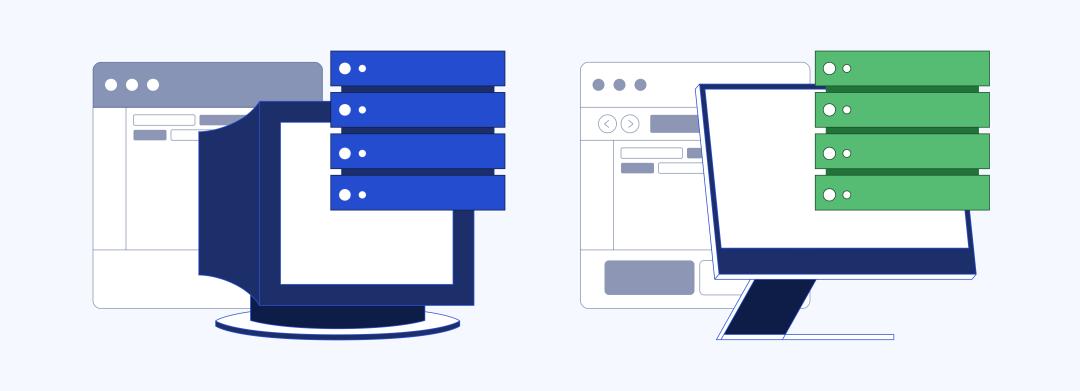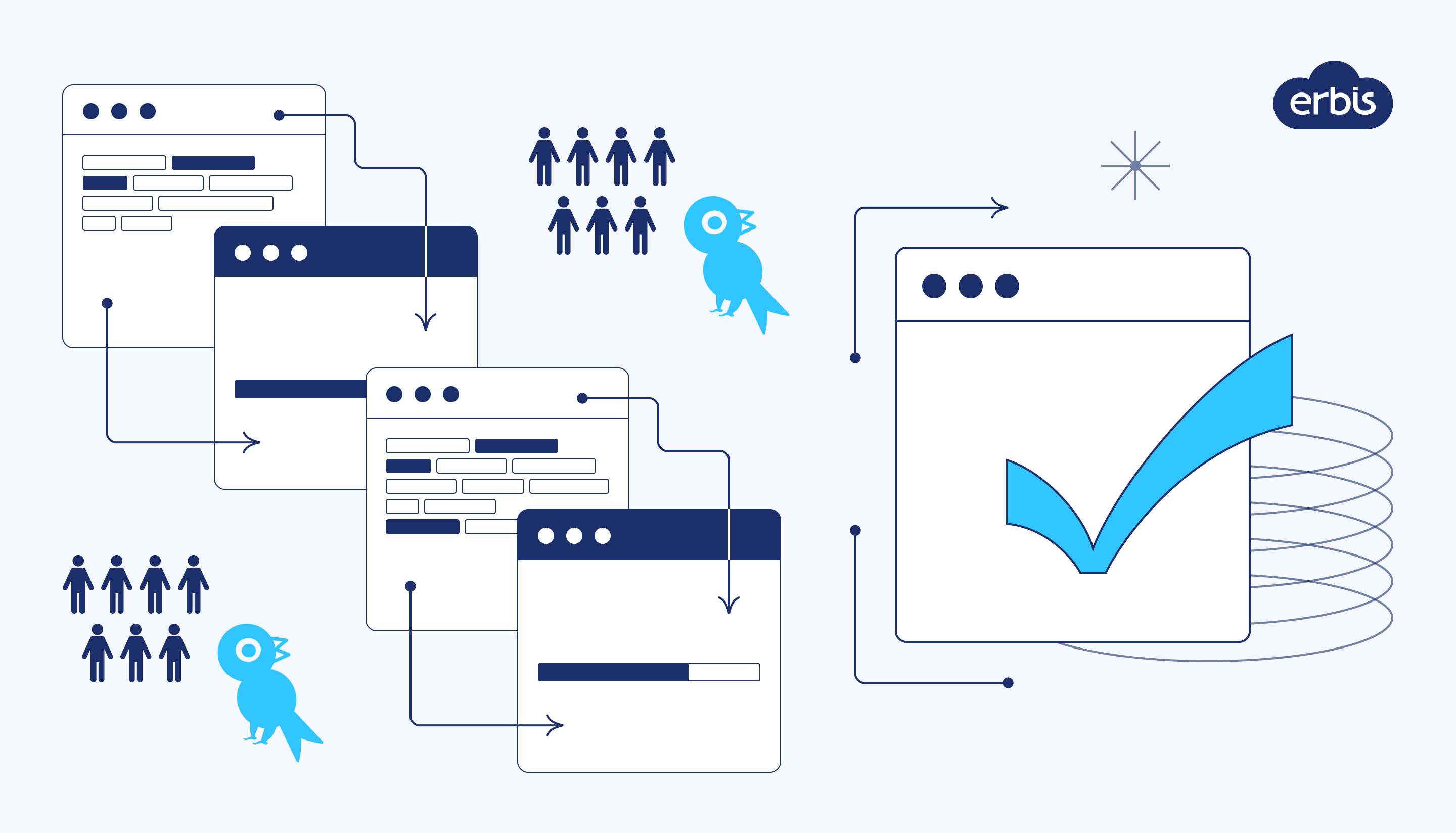Blue-Green vs. Canary Deployment: Different Approaches to Successful Release
Gone are the days when teams scheduled deployment for off-peak times, be it nights or weekends. In the times of SaaS and cloud technologies, when the user can access the product at any time from anywhere, the software must always work consistently well. And given that 72% of organizations prioritize the lack of downtime, effective deployment and release management become even more critical.
Blue-green and canary are two deployment practices that ensure the smooth delivery of software to end users. In this article, we'll consider the difference between blue-green deployment and canary deployment and suggest which will fit you well.
Understanding blue-green vs. canary deployment
Blue-green and canary deployments are two popular deployment methodologies, each with its strengths. To choose between canary vs. blue-green, you need to understand the essence of each.
Blue-green deployment
Blue-green deployment means maintaining two identical environments labeled "blue" and "green." While the current version runs in a blue environment, the new release is set up in the green one. After the green version is tested and verified, traffic is redirected to it, and the blue version becomes idle. The switch between environments is instant, which eliminates downtime during updates.
Blue-green deployment offers a seamless transition between two identical environments and ensures minimal downtime. It minimizes the risk of disruptions during updates and makes it a crucial consideration in the blue-green vs. canary deployment comparison.

Benefits of blue-green deployment:
Zero downtime. Seamless transitions between environments ensure uninterrupted service for users
Quick rollback. Reverting to the previous version is swift by redirecting traffic to the environment that was not affected
Testing in production. Real-world testing occurs without affecting end-users
Canary deployment
Unlike blue-green deployment, which instantly switches to a new product version, canary deployment rolls out the release gradually. The main idea of canary deployment is to introduce changes incrementally to a small group of users called canaries. This allows teams to detect and fix issues before they reach a wider audience. The teams may also roll back to the previous version if a major problem occurs. Thus, the product gets tested and polished until it is ready to be successfully released to the entire user base.
Canary deployment, in the context of blue-green vs. canary strategies, offers a more controlled and cautious approach to updates. This method minimizes the impact of potential issues, ensuring a smoother transition to the new version.

Benefits of canary deployment:
Risk mitigation. Identifying issues early minimizes the impact on a broader user base
User feedback integration. Immediate feedback from the canary group aids in making real-time adjustments
Gradual rollout. Incremental releases help in assessing performance and identifying potential bottlenecks
Difference between blue-green and canary deployment
Blue-green and canary deployment aim to reduce the risk of unsuccessful release but do it in different ways. Blue-green keeps two software instances and switches between them as needed. Canary gradually rolls out updates to a small group of users.
There are three critical parameters by which you can compare canary release vs. blue-green release.
Time
Blue-green deployment is a faster way to update than canary. It instantly switches traffic between two system versions, reducing downtime during releases. Meanwhile, the canary approach introduces changes over an extended period.
Resources
Canary deployment is less resource-intensive compared to blue-green. It does not update the system at a time but introduces the changes gradually. This is opposed to the blue-green deployment, which maintains two identical environments and requires more resources for parallel upkeep.
Project specifics
Blue-Green deployment is great for scenarios requiring instant switchover. It also works well for applications where downtime is a concern, such as financial systems.
Canary deployment is suitable when a cautious rollout is preferred. It is preferable for applications with limited resources. It is also a good fit for software with a strong focus on UX.
Blue-green vs. canary deployment
Blue-green | Canary |
Faster | Slower |
More resource-intensive | Less resource-intensive |
Best for instant switchover | Best for cautious rollout |
Blue-green vs. canary deployment: project suitability guide
Picking between blue-green and canary deployment is critical to ensure an efficient software release. Let's see where each shines.
Blue-green deployment: seamless updates for mission-critical systems
Blue-green deployment fits best scenarios that demand uninterrupted service during updates. It ensures continuous service availability and offers a reliable alternative in the "blue-green vs. canary" debate. Here are six project examples that would benefit from blue-green deployment:
E-commerce platforms. Online stores can't afford downtime during updates. Blue-green deployment ensures a seamless transition for customers.
Financial systems. Banking and financial applications deal with sensitive transactions. Blue-green deployment benefits them with zero-interruption updates.
Electronic healthcare records. Systems managing patient data require uninterrupted service. This makes blue-green deployment a valuable strategy.
Airline reservation systems. In the airline industry, ticketing must be available 24/7. Blue-green deployment ensures continuous service while updating systems.
Online gaming platforms. For gaming platforms with a global user base, uninterrupted availability is critical. Blue-green deployment enables seamless updates without affecting the gaming experience.
Supply chain systems. Systems handling supply chain operations for businesses require continuous availability. Blue-green deployment helps avoid disruptions in logistics operations.
Canary deployment: incremental updates for enhanced UX
Canary deployment is perfect for projects where user experience matters most. It allows you to test new features without going all-in and rolling back if something goes wrong. When deciding on blue-green vs. canary deployment, consider the specifics of your software. Here are the projects that canary deployment benefits most:
Social media platforms. For such systems, user engagement is critical. Canary deployment allows gradual updates without impacting the entire user base.
Content management systems (CMS). Organizations should have constant access to digital content. Canary deployment ensures new features work correctly before a full rollout.
Online collaboration tools. These software products contribute to teams' productivity. Canary deployment minimizes disruptions for users by introducing changes incrementally.
Customer relationship management (CRM) systems. In CRM software, data integrity is crucial. Canary deployment allows for careful testing of updates.
E-learning platforms. Platforms providing online education do not tolerate UX issues. Canary deployment introduces improvements step by step.
Project management tools. PM software is a critical tool for businesses. Canary deployment gradually rolls out new features only when they work perfectly.
Assembling the right development team for efficient release
The success of any deployment strategy, be it blue-green or canary, relies heavily on a skilled development team. Each deployment approach requires specific expertise and knowledge.
Although there are no set guidelines for the team composition while performing a blue-green or canary deployment, some roles are critical.
Blue-green deployment: development team
System architects. They play a crucial role in designing and maintaining the two identical environments (labeled "blue" and "green"). Expertise in creating a robust architecture that supports instant switchover is vital.
DevOps engineers. Responsible for the automation of deployment processes and ensuring seamless transitions between environments. Their expertise ensures minimal downtime during updates.
Release managers. Oversee the planning and execution of releases. Their coordination is essential for a smooth switch between environments and potential rollbacks.
Monitoring specialists. With a focus on real-time monitoring, these specialists help identify issues immediately after the switchover, allowing for prompt resolutions.
Blue-green deployment: required expertise
Understanding of Infrastructure as Code (IaC) principles for automating the creation and management of environments
Proficiency in containerization technologies like Docker, which facilitates consistent deployment across different environments
Expertise in load balancing configurations to manage traffic redirection seamlessly
Canary deployment: development team
Release engineers. They orchestrate the gradual rollout of the new release, ensuring it reaches a small subset of users before broader implementation.
QA engineers. Play a pivotal role in continuous monitoring and testing throughout the phased rollout. Their focus is on identifying and addressing issues incrementally.
DevOps specialists. Responsible for creating CI/CD pipelines that support the incremental update of the system. Automation expertise is crucial for a controlled release.
Data analysts. Monitor user feedback and system performance during the gradual release, allowing for data-driven decisions.
Canary deployment: required expertise
Proficiency in feature flagging to enable selective exposure of new features to a subset of users
Strong understanding of A/B testing methodologies to assess the impact of changes on user experience
Expertise in continuous monitoring tools for real-time insights into the performance and user feedback during the phased rollout
Improving deployments with feedback loops
Making deployments better over time is crucial for both blue-green and canary strategies. In the software world, things change fast, so it's important to stay competitive and evolve.
Organizations should regularly check how deployments are going and find areas for improvement.
In this sense, feedback loops are like having a continuous conversation with your deployment. They help you understand how well things are working. By gathering feedback from users, monitoring tools, and testing results, you improve your release strategies and user satisfaction.
In blue-green deployment, feedback loops help transition between environments smoothly. You keep an eye on things during and after the switch, quickly spot any problems, and fix these problems or go back. This ongoing process ensures that each deployment gets better.
For canary deployment, feedback loops are used to monitor the efficiency of small releases. The step-by-step approach helps teams understand how users react, find potential problems, and fix them before releasing software to more people. Regular feedback ensures the deployment plan meets user expectations and improves their experience.
Choosing the winning deployment strategy with Erbis
Deployment is a crucial step in the software development process. It marks the beginning of delivering the software product to the end-user, and it's essential to ensure that this delivery is seamless and free from bugs.
Blue-green and canary are two distinct approaches to deploying an application. The development team must choose the most optimal approach, keeping in mind the product's requirements and available resources.
At Erbis, we have 11 years of experience working with various software projects across different industries. We treat each project as unique at every stage, from planning to release.
When choosing between blue-green vs. canary, we consider the product's downtime sensitivity, frequency of updates, and user experience specifics. We also ensure that, in either case, deployment goes smoothly and with zero business harm.
If you're looking for a team that can efficiently develop and release your product, don't hesitate to get in touch.
